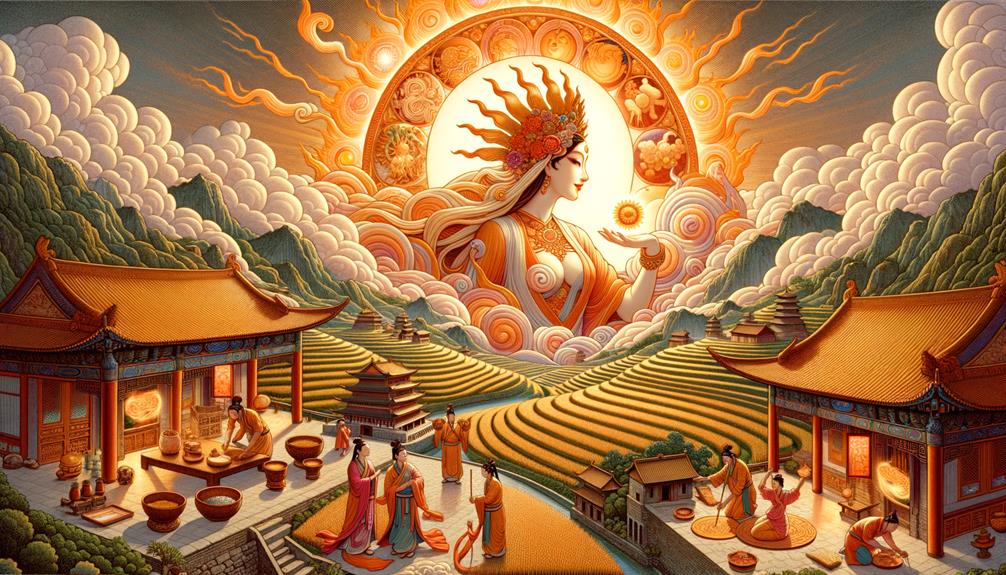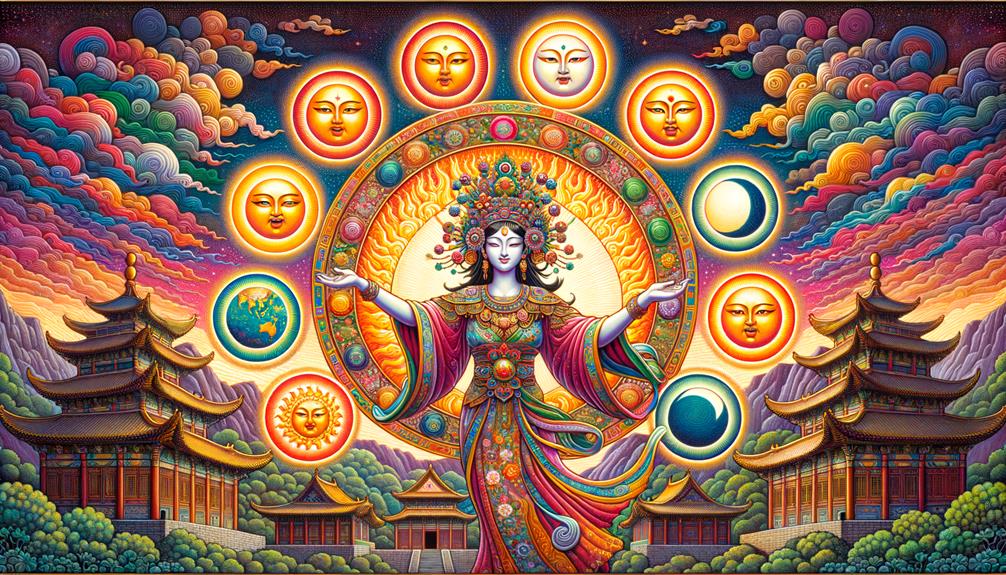This morning, while scrolling through my inbox on my phone, I found myself intrigued by the captivating story of Xihe, the Sun Goddess in ancient Chinese mythology. According to legend, Xihe controls the heavenly dance, leading her sun chariot across the sky, and each of her ten sun-children get a chance to illuminate the world. Apart from symbolizing a natural occurrence, she also encapsulates the ideas of power, motherly sacrifice and the equilibrium of the cosmos. But how does this age-old myth resonate with our contemporary society? Let’s delve deeper and examine Xihe’s story from a modern perspective – there’s certainly more to her than what appears at first glance.
Xihe’s Role in Chinese Mythology

Xihe, a sun goddess in Chinese mythology, is a pretty big deal. Here’s why: she’s the mom of ten suns and also their chauffeur. Picture her leading one of her sun-children, which are basically three-legged birds, from this mulberry tree called Fusang in the eastern sea, every single day.
This wasn’t just a joyride; it was all about maintaining order and balance. But guess what happened when all ten suns decided to make a joint appearance? Pure chaos broke loose. Thankfully, Houyi, a heroic archer, stepped up to save the day by taking down nine of the suns.
Xihe’s story isn’t just a wild adventure; it’s a lesson about control, duty, and the fallout when the natural order gets messed up. It’s safe to say she’s a key player in the storytelling tradition of Chinese mythology.
Understanding the Sun Chariot Symbolism

Let’s chat about the Sun Chariot and its symbolism, shall we? This pivotal part of Xihe’s story underscores her brave role as the pilot of the sun birds’ sky carriage. Xihe, this legendary figure from Chinese mythology associated with the ten suns, signifies a strong equilibrium between light and dark. This balance is evident through her command over the Sun Chariot’s daily route.
Now, imagine these symbolic aspects:
- Xihe rising from the Bright Valley in her Sun Chariot, symbolizes the break of day in ancient periods.
- The Sun Chariot’s repose in the mythical tree, Fusang, is a metaphor for sunset, marking the close of the day.
- The suns being portrayed as three-legged crows embody divine fire that Xihe reins in, showcasing her sway over the sun’s movements.
By putting it in simpler language, we can grasp these complex ideas more easily. Remember, straightforward language goes a long way in clarifying messages. Also, let’s stay current and use language that’s commonly spoken today, avoiding outdated or overly technical terms. We should also veer away from phrases and words that are used too often, and instead, focus on original expressions or straightforward descriptions.
Transition words can be useful, but they don’t always need to be generic. Let’s aim for a more natural flow in our writing. And, while it’s tempting to use exaggeration to emphasize a point, let’s stick to the facts and back up our claims with evidence.
Always keep your audience in mind and adjust your language to suit their level of understanding. Opting for an active voice makes your writing clearer and more direct. And finally, rather than just saying something is ‘important’ or ‘essential,’ let’s explain why it’s significant. This makes the content more engaging and gives the reader a better understanding of the subject.
The Legend of Ten Suns

Let’s chat about a fascinating tale from Chinese mythology. It involves Xihe, the Sun Goddess, who was revered as the mother of ten suns. Now, these weren’t your average suns; they were depicted as three-legged birds. They called a mystical tree named Fusang, found in the eastern sea, their home.
According to the old Chinese stories, each day, Xihe would guide a carriage for one of her sun birds, enabling it to fly around the world. But things got really interesting when all ten sun birds decided to come out at once. This caused a disaster of epic proportions, setting the world on fire.
Now, you may wonder, who came to the rescue? It was none other than Houyi, a master archer. He courageously shot down nine of Xihe’s sun birds, saving the world from total annihilation. Quite a story, don’t you think?
Xihe’s Influence on Chinese Culture
Switching gears a bit, let’s chat about the striking effect Xihe has within Chinese culture. Can you picture Xihe, the sun goddess, in all her glory, symbolizing strength and illumination? This theme ties back beautifully to the old story of Xihe guiding sun birds across the sky. This narrative has woven itself into the very fabric of Chinese mythology.
- Picture Xihe, the sun goddess, radiating the same intensity and brilliance as the sun itself.
- The sun birds in Xihe’s story are imagined as fiery spheres of daylight, spreading heat and illumination.
- This story offers a fresh spin on understanding natural occurrences, tying the daily journey of the sun to a divine action.
Xihe’s epic story and her status as a sun deity cast a bright light on Chinese culture, filling it with aspects of strength, illumination, and heavenly connections.
Modern Representations of Xihe

Wondering how Xihe, the Chinese sun goddess, fits into the modern world? She’s often depicted these days carrying the sun across the sky, which really highlights her role as a sun goddess in Chinese mythology. These images really drive home her celestial powers, reinforcing her status as a deity. But she’s more than just a symbol of divine power – she’s also a symbol of guidance. Her daily trek across the sky, sun in hand, represents the day-to-day cycle we all live through. Even when she’s shown in her crow form, the modern depictions maintain her strong connection to the sun. So, even though Xihe hails from ancient times, she’s still pretty relevant today. Her image is a constant in contemporary art and literature, standing as a symbol of light and control.
Frequently Asked Questions
What Is Xihe the Goddess Of?
Sure, I can chat about that! Xihe, right? She’s a pretty cool figure in Chinese mythology – she’s actually the Sun goddess. And get this, she’s often referred to as the mom of ten suns. It’s a cool way to illustrate her role in guiding and controlling their path every day.
Who Is the Chinese Goddess of the Sun?
In the world of Chinese mythology, the sun’s vibrant vitality takes the form of a goddess. Her name is Xihe, and she’s revered for her strength, her command, and her delicate equilibrium of light and shadow.
Xihe Is a Chinese Language
Actually, Xihe isn’t a language at all. It’s a somewhat common misconception because it’s a name from Chinese mythology. To clear up any confusion, Xihe refers to a goddess, more specifically, the Goddess of the Sun. So, no, it’s not a language, even though it might sound like one to those unfamiliar with Chinese mythology.
What Is the Chinese Sun Myth?
Have you heard about the Chinese Sun Myth? It’s an intriguing story that involves a bit of chaos, problem-solving, and heroism. Just imagine ten sun birds causing an uproar, and then enter Houyi, the archer. He steps in to restore harmony by skillfully shooting down all but one of the disruptive sun birds. Isn’t that a captivating tale?

